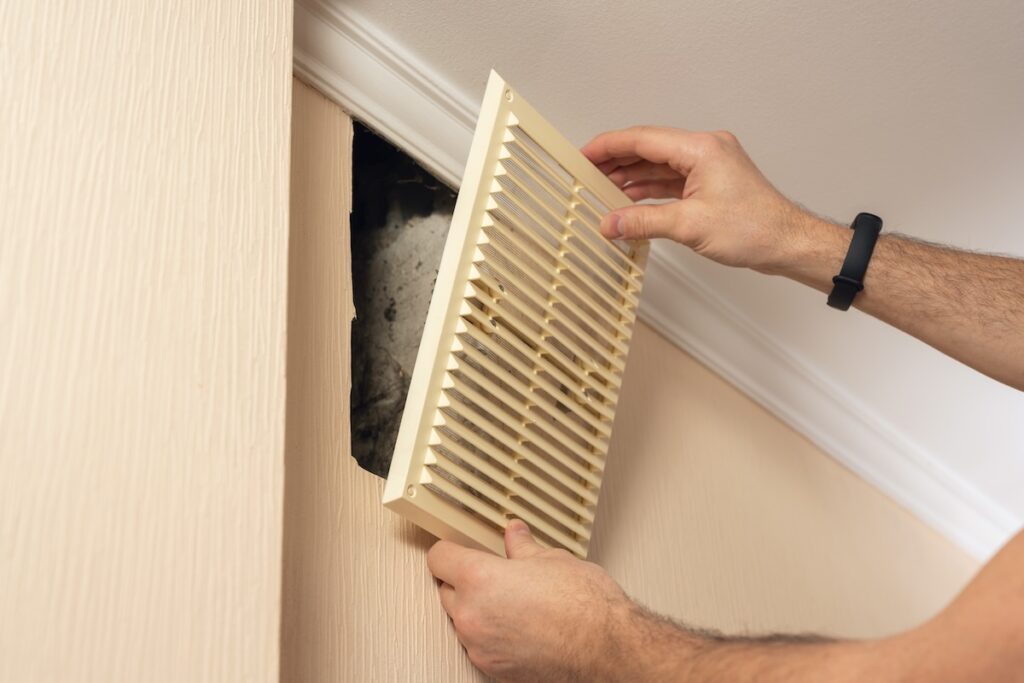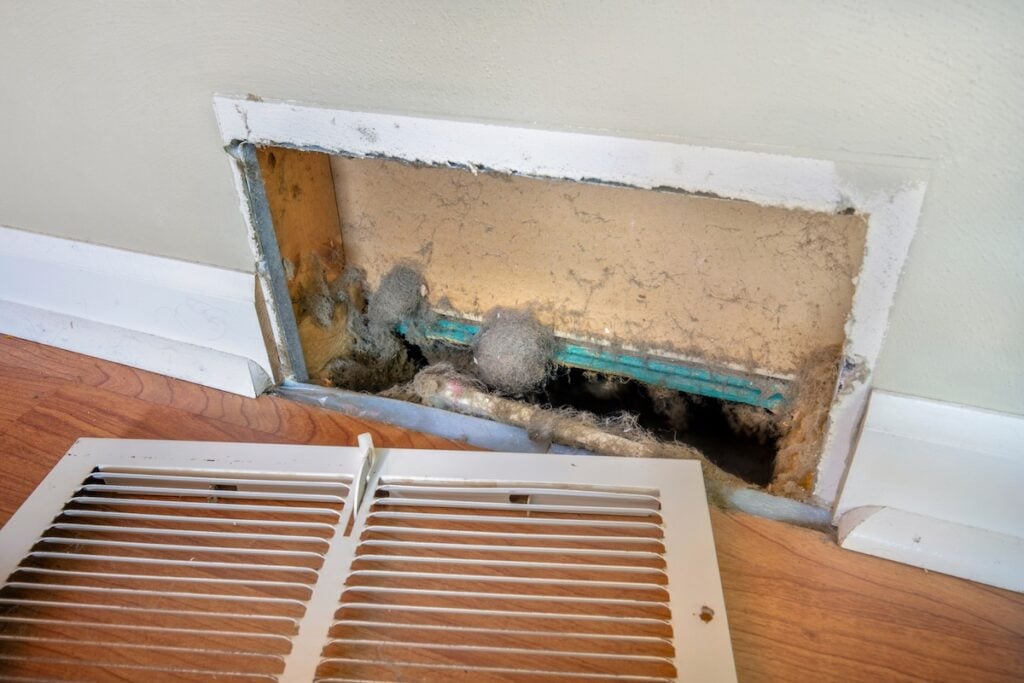7 Signs Of Mold In Air Ducts & Removal Steps
Your HVAC system is designed to keep your home comfortable year-round, but when mold takes hold inside the ductwork, it can compromise both your air quality and your health. Mold in air ducts isn’t always visible, yet it spreads quickly and often goes unnoticed until symptoms appear. This makes awareness and action critical. If you’re concerned about air quality in your home, you can also learn more about air duct cleaning services designed to restore safe, efficient airflow.
In this guide, we’ll explain how to spot mold, what causes it, how to address it, and steps to prevent it from returning.
Here’s what you’ll learn:
- Why mold in air ducts is a serious concern for homeowners
- 7 clear signs that mold may be present in your system
- Common questions about mold, health risks, and removal methods
- Prevention and maintenance tips to protect your home long-term
🏠 Why Mold In Air Ducts Matters

Mold growth inside air ducts is more than an inconvenience—it’s a health hazard and an efficiency killer. When spores circulate through your vents, they affect every room in your home.
Here are the key reasons it matters:
- Health protection: Mold spores aggravate allergies, asthma, and respiratory conditions, especially for children and seniors.
- Air quality: Mold reduces indoor air quality, leaving rooms feeling damp or musty.
- Energy efficiency: Mold buildup restricts airflow, making your HVAC system work harder and raising utility bills.
- Home preservation: Moisture and mold can damage ductwork insulation and even impact walls or ceilings.
🔎 7 Signs You Have Mold In Air Ducts
Mold often hides inside your system, but these warning signs help you detect it early.
1. Musty odors when the system runs
A persistent musty or earthy smell coming from your vents is one of the most obvious signs. The odor is strongest when your HVAC system kicks on.
2. Visible mold growth around vents
Check vent covers and registers. If you notice dark, green, or black spots, that’s a clear indication mold is present in or near the ducts.
3. Increased allergy or asthma symptoms

If family members experience coughing, sneezing, itchy eyes, or worsening asthma indoors, mold spores in the air could be the cause.
- Symptoms often improve when away from home
- Children, seniors, and those with weakened immune systems are most affected
4. Excessive dust buildup
While dust itself isn’t mold, ducts contaminated with mold often collect sticky particles that cling to surfaces, making dust more noticeable.
5. Cold or flu-like symptoms that linger
Mold exposure can trigger headaches, fatigue, and respiratory discomfort that feel like a constant cold.
6. Visible moisture or condensation in ducts
Moisture creates the perfect breeding ground for mold. Signs of water pooling, condensation, or leaky duct insulation suggest risk.
7. Black dust that reappears after cleaning
If you wipe vent covers only to see dark “dust” reappear quickly, it’s often mold growth rather than normal debris.
❓ Mold In Air Ducts: FAQs
Homeowners often have the same questions once mold becomes a concern. Here are clear answers to the most common ones.
- Is mold in air ducts dangerous?
Yes. It can trigger respiratory issues, worsen asthma, and in severe cases, cause long-term health effects. - What causes mold to grow in ducts?
High humidity, poor ventilation, water leaks, or dirty filters can all contribute. - Can I clean mold from ducts myself?
Light surface mold near vents may be wiped away, but full duct cleaning and antimicrobial treatment should be handled by professionals. - Will running the HVAC spread mold further?
Yes. Mold spores travel through the airflow and can spread throughout the house. - How often should ducts be inspected for mold?
At least every 2–3 years, or sooner if you notice odors, health symptoms, or visible growth.
🛠️ Steps To Prevent And Remove Mold

Once mold is in your ducts, removal is necessary. Prevention afterward ensures it doesn’t return.
Professional removal process
A trained HVAC technician will:
- Inspect ducts thoroughly with cameras or specialized tools
- Use high-powered vacuums to remove debris and spores
- Apply antimicrobial treatments to eliminate mold growth
- Re-wrap or replace damaged insulation if needed
DIY prevention measures
While removal should be left to pros, homeowners can help reduce risk:
- Change air filters regularly: Every 1–3 months, depending on usage and household conditions.
- Maintain humidity levels: Keep indoor humidity between 30–50% using dehumidifiers if necessary. Reducing the humidity levels in your house can be a challenging objective, so make sure you do everything you can to do it.
- Check for leaks: Inspect HVAC units, attic ducts, and crawl spaces for signs of water damage.
- Schedule annual tune-ups: Professional inspections catch small issues before they become major.
Cost, Risks, And Professional Support
Understanding the practical side of mold removal helps homeowners plan and act wisely.
Typical cost ranges
- Inspection only: $100–$300
- Partial duct cleaning: $400–$700
- Full cleaning with antimicrobial treatment: $700–$1,200+ depending on home size
DIY vs. Professional Solutions
| Factor | DIY Cleaning | Professional Cleaning |
| Depth of removal | Surface-level only | Entire duct system treated |
| Safety | High risk of spreading spores | Contained and safe |
| Effectiveness | Temporary | Long-lasting |
| Cost | Lower upfront | Higher upfront, but saves on medical and repair costs |
When to call a pro immediately
- Persistent musty odors despite cleaning
- Family members experiencing ongoing health issues
- Visible mold inside multiple vents
- Evidence of moisture or water leaks near HVAC system
🌟 Take Action Against Mold Today
Mold in air ducts is more than a nuisance—it’s a health and comfort issue that affects your entire home. From musty odors to allergy flare-ups, the signs are hard to ignore once you know what to look for. Addressing the problem quickly not only protects your family’s health but also safeguards your HVAC system from long-term damage.
While DIY prevention is smart, full removal requires professional expertise. If you suspect mold in your home’s ductwork, don’t wait until symptoms worsen. For a thorough inspection and safe treatment, contact us today and let our team restore clean, healthy air to your home.
